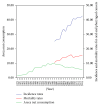Adverse Health Effects of Betel Quid and the Risk of Oral and Pharyngeal Cancers
- PMID: 29376073
- PMCID: PMC5742426
- DOI: 10.1155/2017/3904098
Adverse Health Effects of Betel Quid and the Risk of Oral and Pharyngeal Cancers
Abstract
Global reports estimate 600 million betel quid (BQ) chewers. BQ chewing has been demonstrated not only to be a risk factor for cancers of the oral cavity and pharynx and oral potentially malignant disorders (OPMD) but also to cause other cancers and adverse health effects. Herein, we summarized the international comparison data to aid in the understanding of the close relationship between the prevalence of BQ chewing, the occurrence of oral and pharyngeal cancers, and adverse health effects. Potential biomarkers of BQ carcinogens, such as areca nut, alkaloids, and 3-methylnitrosaminopropionitrile (MNPN), are closely associated with human health toxicology. Molecular mechanisms or pathways involving autophagy, hypoxia, COX-2, NF-κB activity, and stemness are known to be induced by BQ ingredients and are very closely related to the carcinogenesis of cancers of oral and pharynx. BQ abuse-related monoamine oxidase (MAO) gene was associated with the occurrence and progress of oral and pharyngeal cancers. In summary, our review article provides important insights into the potential roles of environmental BQ (specific alkaloid biomarkers and nitrosamine products MNPN) and genetic factors (MAO) and offers a basis for studies aiming to reduce or eliminate BQ-related OPMD and oral/pharyngeal cancer incidences in the future.
Figures




Similar articles
-
Betel nut chewing and its deleterious effects on oral cavity.J Cancer Res Ther. 2014 Jul-Sep;10(3):499-505. doi: 10.4103/0973-1482.137958. J Cancer Res Ther. 2014. PMID: 25313728 Review.
-
The influence of monoamine oxidase variants on the risk of betel quid-associated oral and pharyngeal cancer.ScientificWorldJournal. 2014;2014:183548. doi: 10.1155/2014/183548. Epub 2014 Oct 15. ScientificWorldJournal. 2014. PMID: 25389533 Free PMC article.
-
Cytochrome p450 metabolism of betel quid-derived compounds: implications for the development of prevention strategies for oral and pharyngeal cancers.ScientificWorldJournal. 2013 Aug 1;2013:618032. doi: 10.1155/2013/618032. eCollection 2013. ScientificWorldJournal. 2013. PMID: 23983642 Free PMC article. Review.
-
The neoplastic impact of tobacco-free betel-quid on the histological type and the anatomical site of aerodigestive tract cancers.Int J Cancer. 2012 Sep 1;131(5):E733-43. doi: 10.1002/ijc.27401. Epub 2012 Feb 18. Int J Cancer. 2012. PMID: 22174014
-
Oral exposure to environmental cyanobacteria toxins: Implications for cancer risk.Environ Int. 2021 Mar;148:106381. doi: 10.1016/j.envint.2021.106381. Epub 2021 Jan 19. Environ Int. 2021. PMID: 33465665 Free PMC article.
Cited by
-
Natural phytochemicals that affect autophagy in the treatment of oral diseases and infections: A review.Front Pharmacol. 2022 Aug 25;13:970596. doi: 10.3389/fphar.2022.970596. eCollection 2022. Front Pharmacol. 2022. PMID: 36091810 Free PMC article. Review.
-
Resistance to peer influence, smoking friends, cigarette and betel nut use, and gender among Pacific Islander youth.J Ethn Subst Abuse. 2024 Jan 11:1-19. doi: 10.1080/15332640.2023.2295933. Online ahead of print. J Ethn Subst Abuse. 2024. PMID: 38206103 Free PMC article.
-
Molecular Mechanisms of Malignant Transformation of Oral Submucous Fibrosis by Different Betel Quid Constituents-Does Fibroblast Senescence Play a Role?Int J Mol Sci. 2022 Jan 31;23(3):1637. doi: 10.3390/ijms23031637. Int J Mol Sci. 2022. PMID: 35163557 Free PMC article. Review.
-
Effects of continuity of care on the postradiotherapy survival of working-age patients with oral cavity cancer: A nationwide population-based cohort study in Taiwan.PLoS One. 2019 Dec 16;14(12):e0225635. doi: 10.1371/journal.pone.0225635. eCollection 2019. PLoS One. 2019. PMID: 31841525 Free PMC article.
-
Epidemiology of quid usage and its possible association with the occurrence of oral mucosal lesions.Front Oral Health. 2024 Nov 27;5:1450729. doi: 10.3389/froh.2024.1450729. eCollection 2024. Front Oral Health. 2024. PMID: 39664881 Free PMC article.
References
-
- Gupta P. C., Ray C. S. Epidemiology of betel quid usage. Annals of the Academy of Medicine, Singapore. 2004;33(4, supplement):31–36. - PubMed
-
- Tovosia S., Chen P. H., Ko A. M., Tu H. P., Tsai P. C., Ko Y. C. Prevalence and associated factors of betel quid use in the Solomon Islands: a hyperendemic area for oral and pharyngeal cancer. The American Journal of Tropical Medicine and Hygiene. 2007;77(3):586–590. - PubMed
Publication types
MeSH terms
Substances
LinkOut - more resources
Full Text Sources
Other Literature Sources
Medical
Research Materials

